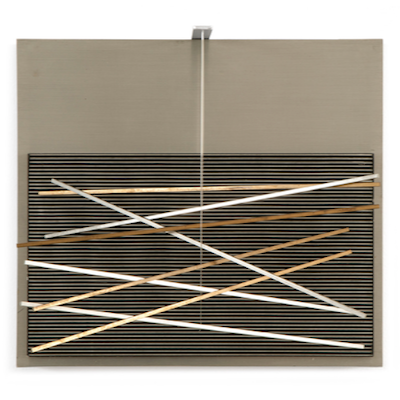



Details
Artist
Styles
Set of eight 3D sculptures/objects from the portfolio 'Oeuvres Profondes Cinetiques' by Victor Vasarely. One object consists of two lithograph prints - one printed on transparent medium and one on heavy paper. When positioned one on top of another with right distance, superposition creates an optical effects depending on viewing angle. - Custom framed in gallery wooden frames with glass. - Published by: Editions du Griffon Neuchatel, 1973. - Printed in Switzerland // Oeuvres Profondes Cinétiques by Victor Vasarely is a captivating set of eight serigraphic objects that exemplify his mastery in kinetic and optical art. Each piece in this series features a unique arrangement of geometric patterns created through layered prints—one printed on a transparent medium and another on heavy paper. When positioned correctly, the overlapping layers produce intricate optical effects that shift with the viewer's angle, creating illusions of depth and movement. The black-and-white tones enhance the complexity of the visual experience, drawing attention to the interplay of light, shadow, and perspective. Custom framed in wooden gallery frames with glass, this set, published by Editions du Griffon Neuchatel in 1973, embodies Vasarely’s innovative exploration of perception and dimensionality.
Oeuvres Profondes Cinetiques
form
Medium
Size
29 x 29 X 4 cm
- Inches
- Centimeters
Edition
Price
- USD
- EUR
- GBP
Details
Artist
Styles
Set of eight 3D sculptures/objects from the portfolio 'Oeuvres Profondes Cinetiques' by Victor Vasarely. One object consists of two lithograph prints - one printed on transparent medium and one on heavy paper. When positioned one on top of another with right distance, superposition creates an optical effects depending on viewing angle. - Custom framed in gallery wooden frames with glass. - Published by: Editions du Griffon Neuchatel, 1973. - Printed in Switzerland // Oeuvres Profondes Cinétiques by Victor Vasarely is a captivating set of eight serigraphic objects that exemplify his mastery in kinetic and optical art. Each piece in this series features a unique arrangement of geometric patterns created through layered prints—one printed on a transparent medium and another on heavy paper. When positioned correctly, the overlapping layers produce intricate optical effects that shift with the viewer's angle, creating illusions of depth and movement. The black-and-white tones enhance the complexity of the visual experience, drawing attention to the interplay of light, shadow, and perspective. Custom framed in wooden gallery frames with glass, this set, published by Editions du Griffon Neuchatel in 1973, embodies Vasarely’s innovative exploration of perception and dimensionality.
- Recently Added
- Price (low-high )
- Price (high-low )
- Year (low-high )
- Year (high-low )
What is kinetic art?
Kinetic art is an international movement that emerged in the 1920s and gained prominence in the 1960s, referring to art that involves both apparent and real motion. It encompasses any medium that includes movement, either relying on actual motion for its effect or being perceived as moving by the viewer. Early examples include canvas paintings designed to create optical illusions of movement. Today, kinetic art often refers to three-dimensional figures and sculptures, such as those operated by machines or those that move naturally. The movement covers a variety of styles and techniques that frequently overlap.











































































